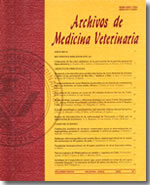Biology of pregnancy in the domestic cat (Felis catus)
Main Article Content
Abstract
The domestic cat can be defined as a seasonal poliestrous female. During mating the physical stimulus produce the release of LH and ovulation, which occur during the first 50 hours post mating. The fertilization of oocytes takes place inside the oviduct during the 30 hours post ovulation. The embryos transport on the oviduct takes about 132 hours and when embryos reach the uterus they are already a compacted morulae. After this, the blastocyst migrates to both uterine horns for a period of 80 hours aproximately until implantation ocurrs 12 to 13 days after mating. During the preimplantation period, there is a significant increase in blood progesterone and also in LH lutheal receptors. From the second half of gestation, the production of progesterone decrease and prolactin secretion increase. Thus it is thought that the later would be the main luteotrophic agent in the cat. Also during the second half of gestation the secretion of relaxin increase. The production and function of progesterone during late gestation is controversial. It has been shown that placenta of cats has a steroidogenic function and that it is also to produce progesterone.

